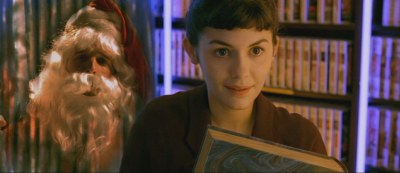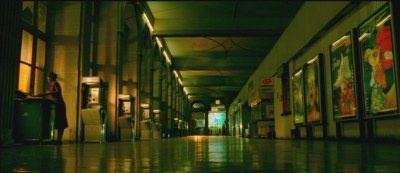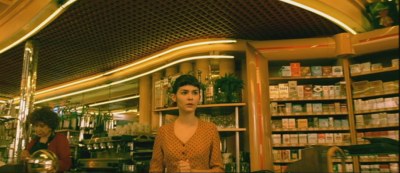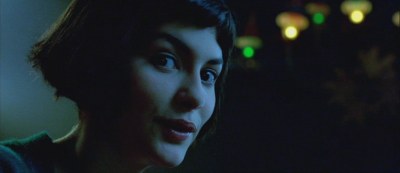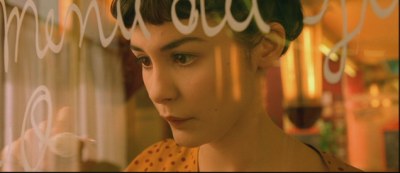Hollywood likes to laugh at the French filmmakers
because they want to make works of art before they know how to remove
the lens cap. Well, France just achieved total technical parity, and
maybe even a bit more. The cinematography and editing employed here
are
absolutely at a virtuoso level.
The story:
Amelie was a lonely girl who grew up to be a charming,
naive, withdrawn adult. One day, a fateful circumstance led her to
discover a box of children's toys from the fifties. She ingeniously
contrived to return them to their owner, and this had such a positive
effect on her and the owner, that she resolved to become a regular
do-gooder, but always at a safe emotional and physical distance. For
example, she gave the toy box back by placing it in a public phone
booth, then dialing the number as the owner passed. Of course, he
thought it must be miraculous.
At the same time, Amelie had discussions with a
reclusive old man who kept repainting Renoir's "Luncheon of the
Boating Party" every year, but could never quite get the correct facial
expression on one girl. Amelie came to identify with this girl, and
got to talk about her own life with the old man by using the girl in
the painting as a surrogate. This process led her to seek richer
interaction with people in her own life.
Renoir's painting serves as an excellent connection
between the visual world of the Impressionists, and the visual world
of this film, which creates a filmed impressionism or
post-impressionism of its own.
And then there is the mystery of the man who appears in
so many discarded photo booth pictures throughout Paris. Just who is
he?
|
DVD info from Amazon - two disks
• The "Amélie
Effect" (English) Featurette
• The "Look of Amélie" (English) Featurette
• Fantasies of Audrey Tautou (French with English subtitles)
• Q & A with Director Jean-Pierre Jeunet (English)
• Q & A with Director and Cast (French with English subtitles)
• Auditions -- Audrey Tautou, Urbain Cancelier, Yolande Moreau
(French with English subtitles)
• Storyboard Comparison
• An Intimate Chat with Jean-Pierre Jeunet (French with English
subtitles)
• Home Movies - "Inside the Making of Amélie" (French with
English subtitles)
• "A Quai" Music Video
• The Amélie Scrapbook -- "Behind the Scenes," French Poster
Concepts
• "The Garden Gnome's Travels" and Storyboards
• Widescreen anamorphic format, 2.35:1
|
|
It's a terrific movie, and a great directorial
achievement. I just can't fathom why Jean-Pierre Jeunet was not
nominated for the Best Director Oscar. No other directing achievement
of 2001 approaches this film except Baz Luhrmann for Moulin Rouge, and
this is a much richer film than Moulin Rouge in many ways. I don't
mean to denigrate what Ron Howard did in A Beautiful Mind. Indeed,
perhaps A Beautiful Mind is a better film, because Amelie is simply a
confection. But what a confection, and the contribution of the
director to Amelie was present in every camera perspective, in every
color filter, in every actor's glance, in every technical trick. It is
a director's film, pure and simple. Jeunet could not have been more
responsible for it if he had held a brush and painted it on canvas
like Renoir. |
| Tuna's
thoughts in yellow:
In places, it was downright laugh out
loud hilarious. Someone convinced the child Amelie that she was causing
traffic accidents by taking pictures with her camera. When she realized
she had been had, she came up with a great method of revenge. She got on
his roof with a TV, and waited for each goal opportunity in the soccer
match he was watching to unplug his cable.
Scoop also mentioned that it was a director's picture, and intelligent.
The example that struck me was that, even though they had a narrator,
the narrator provided mood, not exposition, and not speaking French is
not a big disadvantage in this film, as the director showed you what was
going on, rather than telling you. |
The
Critics Vote
General UK consensus:
three stars.
Daily
Mail 6/10, The Guardian 6/10, Evening Standard 7/10, The
Express 10/10, The Mirror 8/10, BBC 4/5
|
The People
Vote ...
- IMDB summary.
IMDb voters score it 8.9/10 (#13 of all time), Guardian
voters 8.5/10. It is the all-time date
movie, since men and women both think it is a masterpiece (men
8.9, women 9.1), and they like it about equally.
- with their dollars: a phenomenal success,
grossing $33 million in the USA despite being in French with
subtitles, and never being on more than 303 screens.
(Blockbusters are shown on ten times as many screens.). Was
seen by 8.6 million people in France - about 15% of the
population - roughly equivalent to a $300 million
blockbuster in the USA.
|
| IMDb
guideline: 7.5 usually indicates a level of
excellence, about like three and a half stars
from the critics. 6.0 usually indicates lukewarm
watchability, about like two and a half stars
from the critics. The fives are generally not
worthwhile unless they are really your kind of
material, about like two stars from the critics.
Films under five are generally awful even if you
like that kind of film, equivalent to about one
and a half stars from the critics or less,
depending on just how far below five the rating
is. My own
guideline: A means the movie is so good it
will appeal to you even if you hate the genre. B means the movie is not
good enough to win you over if you hate the
genre, but is good enough to do so if you have an
open mind about this type of film. C means it will only
appeal to genre addicts, and has no crossover
appeal. D means you'll hate it even if you
like the genre. E means that you'll hate it even if
you love the genre. F means that the film is not only
unappealing across-the-board, but technically
inept as well.
Based on this description, this
film is a B+ or an A. It is an artistic achievement, a critical
success, and a crowd-pleasing entertainment. It is intelligent,
clever, witty, and beautiful. What the hell else is there? Any
filmmaker would be proud to have created this film. (Tuna:
Film just
doesn't get much better than this. This film is, to me, an A. It
seems to have universal appeal, even though it is in French and
subtitles. Any other year, the film would have had an Oscar
nomination for Best Picture, and probably should have taken Best
Director.)
|
|

